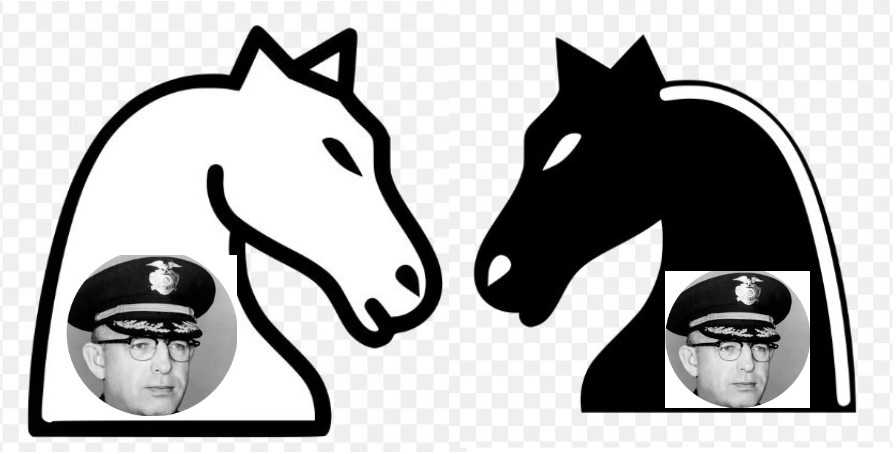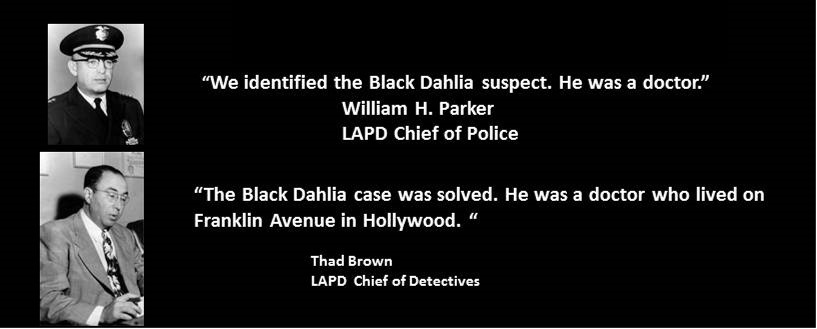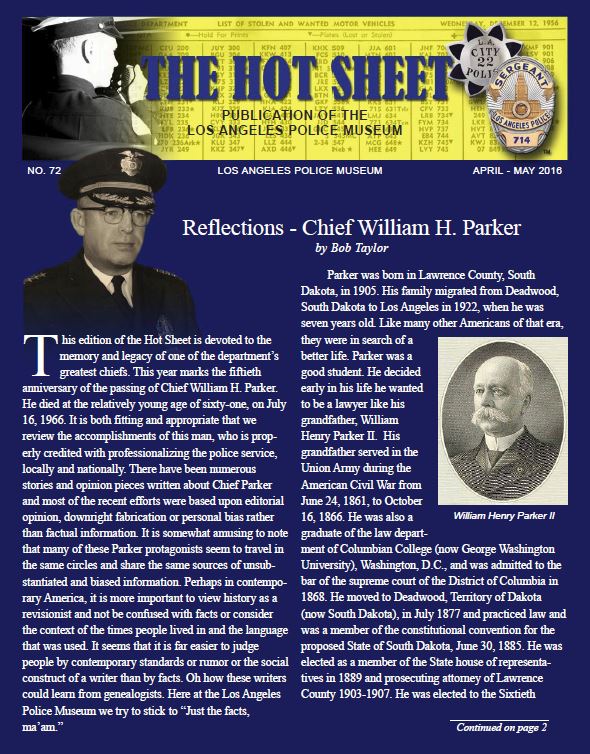Chief William H. Parker: LAPD's Black and White Knight: A Fifty Year Restrospective
September 6, 2016
Los Angeles, California
…Bosch had an idea what was coming. The fixer was here now. The investigation was about to go through the spin cycle where decisions and public pronouncements would be made based on what best served the department, not the truth.”
From Angels Flight by Michael Connelly
LAPD CHIEF WILLIAM H. PARKER:
WHITE KNIGHT BLACK KNIGHT


THE WHITE KNIGHT
Robert “Bob” Taylor is the Immediate Past Chairman of the Los Angeles Police Museum’s Board of Directors. In the April/May 2016 Museum’s newsletter known as “The Hot Sheet, ” Bob devoted the entire edition to the memory of former LAPD police chief William H. Parker. (This year is the fiftieth anniversary of Parker’s death in 1966.)
Bob has written an outstanding article summarizing Chief Parker’s life and service to the City of Los Angeles. I highly recommend you take the time to read it in its entirety. It is attached here as a PDF and can also be read on-line at the following link which will direct you to it at the Police Museum’s web page.
laphs chief parker life summary
THE BLACK KNIGHT
In the eyes of most of the LAPD Chief William H. Parker remains legendary. Right up there with men like Gen. George S. Patton and J. Edgar Hoover. In 1950, he took command of a highly corrupt Department and for the next sixteen years ruled with an iron fist, retooled and professionalized the Police Academy training and marketed his “New Breed” by turning on the bright klieg lights of Hollywood, capturing national attention with the introduction of the new TV series, “Dragnet” starring, Sgt. Joe “Just the Facts” Friday (Jack Webb) and positioning his “No. 2 Man” Chief Thad Brown as the show’s technical advisor.
Chief Parker known as “Whiskey Bill” was tough as nails hard and uncompromising. Here is a personal anecdote to illustrate the point.
In 1964, I was a rookie patrol officer with just over a year on the job. I was assigned to Wilshire Division, Morning Watch.
One morning, at about 4:00 A.M. the following broadcast was received from Communications Division. “Attention all Wilshire Division patrol officers. Report to Wilshire Station “Code 2.” (Code for “immediately, without delay.) I and my partner, along with all of the other uniformed officers (about ten two-man teams as I recall) did so, and the Watch Commander had all of us report upstairs to the Roll Call Room.
We were lined up side by side in a long row, order to “attention” and the Watch Commander, accompanied by a middle-aged woman of Chinese decent entered the squad room, and the two of them did a “walk by” as she looked into each one of our faces. The two then left and we were then ordered back to the field to resume our patrol duties.
Long story short, turns out that the woman had been walking home from a local bar, highly intoxicated and was stopped as she was about to enter her apartment, by a uniformed officer and his young probationer, who had just graduated from the Academy. Both officers approached her on the sidewalk and it was obvious that she was intoxicated. The senior officer then ordered his partner to “get in the car and listen to the police radio in case we get a hot call. I’ll make sure she gets to her apartment OK.” The rookie followed orders and sat in the patrol car. About fifteen minutes later, his partner came out of the apt building, and they resumed patrol.
A few minutes later, the woman’s boyfriend returned home, found her asleep on the couch in what can only be described as a highly compromised condition. (Her face and clothing were covered with semen.) She informed her boyfriend that a police officer had threatened to arrest her for “drunk and disorderly” but would “let her slide if she gave him a blowjob.” She did, and he did, returning to his partner who unaware of any misconduct or crime waited patiently in the car.
The irate boyfriend drove her to Wilshire Station and informed the Watch Commander who then immediately had all of his patrol officers report to the station for a “live show-up.”
The victim subsequently positively identified the one officer from the show-up, he and his partner were interviewed, the senior officer admitted it and his partner, rightfully claimed, “no knowledge.” In a later “Board of Rights Hearing” Chief Parker had both officers fired on the spot. Parker’s position in regards to the rookie/probationer was ” no matter, he should not have allowed his partner to go with the woman by himself.” (The probationer on appeal was later reinstated.)
The point of the story being that for Chief Parker there were no “mitigating circumstances.” Policework like Life was “Black and White.” There was only “Good and Bad.” “Right and Wrong.” Unfortunately, this “philosophy” and his personal view of life, carried over to his troops and became a “Us and Them” mentality, which Parker strongly promoted calling it “proactive policing.” These hardline attitudes divided the citizenry and would be partly to blame for what two years into my career under Parker’s command became known as, “The Watts Riots.” (As noted by many researchers, the underlying causes of the Watts Riots were many and LAPD’s “proactive, hardline policing” was only one piece of a very complex puzzle.)
In Black Dahlia Avenger II, I include a chapter that contains several important sections that focus on Chief William H. Parker. As introduction to that section I wrote:
In 1963, as young, idealistic rookie cops, my partners and I really believed we were Chief Parker’s “Thin Blue Line.” At police academy graduation, he looked us in the eye, shook our hand, and told us that was so. Life for me back then was literally and philosophically, “black and white.”
Today, decades later, I realize that neither life nor people were ever that simple. Most of us are a combination of the two—black and white—which makes for lots of gray.
Today, with a much fuller historical perspective and understanding, I realize that my early hero, Chief Parker, was both a white and a black knight.
In that chapter, I include: “Parker on Police” which presents Parker’s 1949 private verbatim conversations with LAPD Vice-Sergeant, Charles Stoker as discussed in Stoker’s 1950 expose, Thicker’N Thieves.
I also quote from Parker’s book, Parker on Police (Charles C. Thoms, Springfield, Ilinois 1957) which includes his 1954, direct testimony before the Appropriations Committee, House of Representatives, in Washington, DC. Parker in speaking to the Committee, introduces his theory on, “The Law of Double Effect.” He uses this concept in his defense to push for the passage of laws allowing police to eavesdrop using hidden microphones and recording devices to crush crime. (As we know, this was done by DA/LAPD at the Hodel residence just three years earlier on the Black Dahlia Task Force stakeout.)
I am here attaching a PDF scan of that section of Black Dahlia Avenger II, for those interested in obtaining a deeper understanding of Chief Parker’s philosophy, coming from his own mouth.

Steve,
I like the Detective Harry Bosch quote you opened with. I, like you, am a big fan of Michael Connelly.
Steve, do you think the decision to close down the DA’s investigation of GHH was ultimately made by Chief Parker? Did he have that kind of sway with the DA? It also seems likely that he must have been the one who ordered that the Black Dahlia investigative materials dissappear.
Regards,
Jim
Hi James: Thanks for the kind words.
I think the decision was a “meeting of the minds” of the police and political powers at the time.
What we KNOW is that DA Lt. Frank Jemison who had solved the case and was about to seek a warrant for the arrest of Dr. George Hill Hodel in March 1950, was summoned to his boss’ office and ordered to hand over everything, reports, tapes, photos, all to LAPD Chief Thad Brown and “shut it down” and not keep anything. He did this, with the exception of secretly locking away a copy of the investigation and DA Hodel/Black Dahlia transcripts in the DA vault, which would not be uncovered until my investigation in 2002. I suspect the late night meeting likely involved: DA Simpson, LAPD Chiefs Bill Parker and Thad Brown, Chief of DA Bureau of Investigation H. Leo Stanley and his top Lt. Frank Jemison. Parker was just weeks away from being appointed the new chief, and the rationale was to lock it away, let Parker clean up Dodge, and come back to it at some future time. (Of course, they never did.) All Best, skh
P.S. Also, since you are a big fan of Harry Bosch, thought you might like, if you haven’t seen it the following link.
http://stevehodeloldsite.staging.authorbyteshosting.com/2015/11/author-michael-connellys-hieronymos-harry-bosch-an-identity-crisis/
Hi Steve, To me the bottom line with LAPD Chief William Parker, as with any chief of police, should have been pursuing justice for victims and their families and removing the culprit from society. This was not done by the “powers that be” in LA. Why? I am sure there was a network of celebs, politicians, financial / religious community bigwigs that could not let this happen! Perhaps many of them were the recipients of George Hodel’s medical services. The unfortunate result of their refusal to pursue a warrant to arrest George Hodel based on all the investigative evidence could have caused the deaths of many more people. I remember as a child listening to my father, uncles, police buddies so proudly comparing the SFPD and LAPD reputations back in the 40’s & 50’s. To them, at least in party conversations, SF was a paragon of virtues compared to LA! Hah! What happens in LA also happens in SF and unfortunately far beyond. Hence no final closures for so many murder victims & their families! Yes, we all are made up of “black & white” resulting in hopefully a fairly decent grey. But in this case the “black” obliterates any white/grey salvation for the community of leaders that refused and still refuses to speak up and own their actions!!
Patricia: I agree. You say that “their refusal to pursue and arrest George Hodel based on the investigative evidence,could have caused the deaths of many more people.” As pointed out in my several books, I would add that not only could it have, but it, in fact, DID. This is where LAPD and the City officials have major blood on their hands. Had they pursued justice and arrested GHH back then, or obtained a warrant and extradited him from Hawaii or the Philippines, there would have been no Lucila Lalu murder in Manila. No Cheri Jo Bates murder in Riverside. And none of the additional “Zodiac Murders” would have been committed in the San Francisco Bay Area in 1968 and 1969. Such are the consequences of officers failing to do their duty. Unable to solve murders is one thing, but solving them and allowing a serial killer to remain free to kill again and again, simply out of fear of political and personal repercussions is beyond my understanding. Imagine how this must have weighed so heavily on the minds of those WHO KNEW AND DID NOTHING.
Amen Steve! As I learned years ago in my career as a teacher of students with multiple disabilities “Silence is not Golden”! A school psychologist gave me some sage advice I never forgot: Sunlight is the best disinfectant, Mrs. O’Neill, and I mean that both physically and mentally! Air your difficulties or information fast….fast and quick with all parties involved, parents, administrators, police if needed!” I followed that advice until retirement! Well, you certainly did that upon discovering the truth about your father! What is difficult to grasp is that solution and closure do not always come “fast and quick” despite all our efforts. Sometimes we just provide the glimmer of light at the end of the tunnel. And that’s a good thing, Steve! Best regards, Pat O’Neill. 😀
Steve,
Good afternoon, do you have any literature about the reasons Chief Parker decided to implement the Board of Rights, when and how?
THANK YOU
Marlon: Sorry, no I haven’t researched the Board of Rights background/history. I seem to recall that Parker worked on the City Charter sections in the Thirties as a young lawyer and managed to get many critical sections included which granted the Chief of Police powers and increased autonomy over his subordinates such as the Board of Rights Hearing Process. I have always thought of it more as a Kangaroo Court within the Department and a way to avoid “due process” by not allowing the officer to have “his day in court.” (Think Sgt. Charles Stoker, the Vice Officer/Whistle Blower who was fired for revealing internal corruption. And of course, many more such cases through the decades.) Regards, SKH.
Steve,
Thanks for responding, I was an Advocate for 4 years and put on many BORs, our police union filed a lawsuit stating that “due process” of officers are violated before this hearing. It’s my understanding that Chief Parker implemented this hearing due to his military experience with BOIs. Can you guide me in the right direction, if any, about the charter changes back then or any literature that may be available.
Thank You
Marlon: See below link page 11 “In 1926 the City Charter was amended to give the Department sole disciplinary power over its members. This apparently was in response to felt political intrusion into internal affairs of the Department. …Parker formed a Bureau of Internal Affairs in 1948…” This is a starting point, good luck and good hunting. SKH
https://www.law.umaryland.edu/marshall/usccr/documents/cr12p75.pdf
and
http://www.lapdonline.org/lapd_manual/volume_2.htm